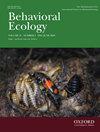警示蛾多组分预警信号对捕食者选择的影响
IF 2.2
3区 环境科学与生态学
Q2 BEHAVIORAL SCIENCES
引用次数: 0
摘要
示警的猎物用明显的警告信号来宣传它们的无利可图,这些信号通常由多种颜色图案组成。许多物种在这些模式中表现出种内变异,尽管自然选择倾向于不变的警告信号,以增强捕食者的学习能力。然而,如果捕食者获得了对特定信号成分的回避,这可能会放松对其他警告特征的选择,并解释变异。在这里,我们研究了这一想法在警告飞蛾黑麻,具有明显的黑色和橙色的颜色。翅膀上橙色斑点的大小在个体之间变化很大,而腹部橙色条纹的数量和宽度是一致的。我们制造了不同比例的翅膀橙色或腹部条纹的人造飞蛾。我们将这些信号呈现给一种天然的鸟类捕食者,吵闹的矿工(Manorina melanocephala),并记录不同的警告信号成分如何影响它们的攻击决策。当飞蛾模型腹部有橙色条纹时,鸟类不会区分不同的翅膀信号。然而,当腹部的条纹被移除时,鸟类选择了翅膀上斑点较小的模型。此外,我们发现鸟类更有可能攻击腹部条纹数量较少的飞蛾。综上所述,我们的研究结果表明,鸟类捕食者主要关注黑黑的腹部条纹,这可以放松对翅膀颜色的选择。我们的研究强调了考虑单个警告信号成分的重要性,如果我们要了解捕食者如何对猎物的警告颜色进行选择。本文章由计算机程序翻译,如有差异,请以英文原文为准。
Predator selection on multicomponent warning signals in an aposematic moth
Aposematic prey advertise their unprofitability with conspicuous warning signals that are often composed of multiple color patterns. Many species show intraspecific variation in these patterns even though selection is expected to favor invariable warning signals that enhance predator learning. However, if predators acquire avoidance to specific signal components, this might relax selection on other aposematic traits and explain variability. Here, we investigated this idea in the aposematic moth Amata nigriceps that has conspicuous black and orange coloration. The size of the orange spots in the wings is highly variable between individuals, whereas the number and width of orange abdominal stripes remains consistent. We produced artificial moths that varied in the proportion of orange in the wings or the presence of abdominal stripes. We presented these to a natural avian predator, the noisy miner (Manorina melanocephala), and recorded how different warning signal components influenced their attack decisions. When moth models had orange stripes on the abdomen, birds did not discriminate between different wing signals. However, when the stripes on the abdomen were removed, birds chose the model with smaller wing spots. In addition, we found that birds were more likely to attack moths with a smaller number of abdominal stripes. Together, our results suggest that bird predators primarily pay attention to the abdominal stripes of A. nigriceps, and this could relax selection on wing coloration. Our study highlights the importance of considering individual warning signal components if we are to understand how predation shapes selection on prey warning coloration.
求助全文
通过发布文献求助,成功后即可免费获取论文全文。
去求助
来源期刊

Behavioral Ecology
环境科学-动物学
CiteScore
5.20
自引率
8.30%
发文量
93
审稿时长
3.0 months
期刊介绍:
Studies on the whole range of behaving organisms, including plants, invertebrates, vertebrates, and humans, are included.
Behavioral Ecology construes the field in its broadest sense to include 1) the use of ecological and evolutionary processes to explain the occurrence and adaptive significance of behavior patterns; 2) the use of behavioral processes to predict ecological patterns, and 3) empirical, comparative analyses relating behavior to the environment in which it occurs.
 求助内容:
求助内容: 应助结果提醒方式:
应助结果提醒方式:


